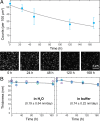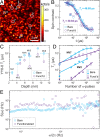Biocompatible surface functionalization architecture for a diamond quantum sensor
- PMID: 35193961
- PMCID: PMC8872777
- DOI: 10.1073/pnas.2114186119
Biocompatible surface functionalization architecture for a diamond quantum sensor
Abstract
Quantum metrology enables some of the most precise measurements. In the life sciences, diamond-based quantum sensing has led to a new class of biophysical sensors and diagnostic devices that are being investigated as a platform for cancer screening and ultrasensitive immunoassays. However, a broader application in the life sciences based on nanoscale NMR spectroscopy has been hampered by the need to interface highly sensitive quantum bit (qubit) sensors with their biological targets. Here, we demonstrate an approach that combines quantum engineering with single-molecule biophysics to immobilize individual proteins and DNA molecules on the surface of a bulk diamond crystal that hosts coherent nitrogen vacancy qubit sensors. Our thin (sub-5 nm) functionalization architecture provides precise control over the biomolecule adsorption density and results in near-surface qubit coherence approaching 100 μs. The developed architecture remains chemically stable under physiological conditions for over 5 d, making our technique compatible with most biophysical and biomedical applications.
Keywords: NV center; biocompatible functionalization; diamond surface modification; quantum sensing.
Copyright © 2022 the Author(s). Published by PNAS.
Conflict of interest statement
Competing interest statement: The authors have filed a provisional patent application for the diamond functionalization process described in this manuscript.
Figures




References
-
- Lovchinsky I., et al. , Nuclear magnetic resonance detection and spectroscopy of single proteins using quantum logic. Science 351, 836–841 (2016). - PubMed
-
- Shi F., et al. , Protein imaging. Single-protein spin resonance spectroscopy under ambient conditions. Science 347, 1135–1138 (2015). - PubMed
-
- Shi F., et al. , Single-DNA electron spin resonance spectroscopy in aqueous solutions. Nat. Methods 15, 697–699 (2018). Correction in: Nat. Methods 15, 749 (2018). - PubMed
-
- Schmitt S., et al. , Submillihertz magnetic spectroscopy performed with a nanoscale quantum sensor. Science 356, 832–837 (2017). - PubMed
-
- Boss J. M., Cujia K. S., Zopes J., Degen C. L., Quantum sensing with arbitrary frequency resolution. Science 356, 837–840 (2017). - PubMed
MeSH terms
Substances
LinkOut - more resources
Full Text Sources
Other Literature Sources

